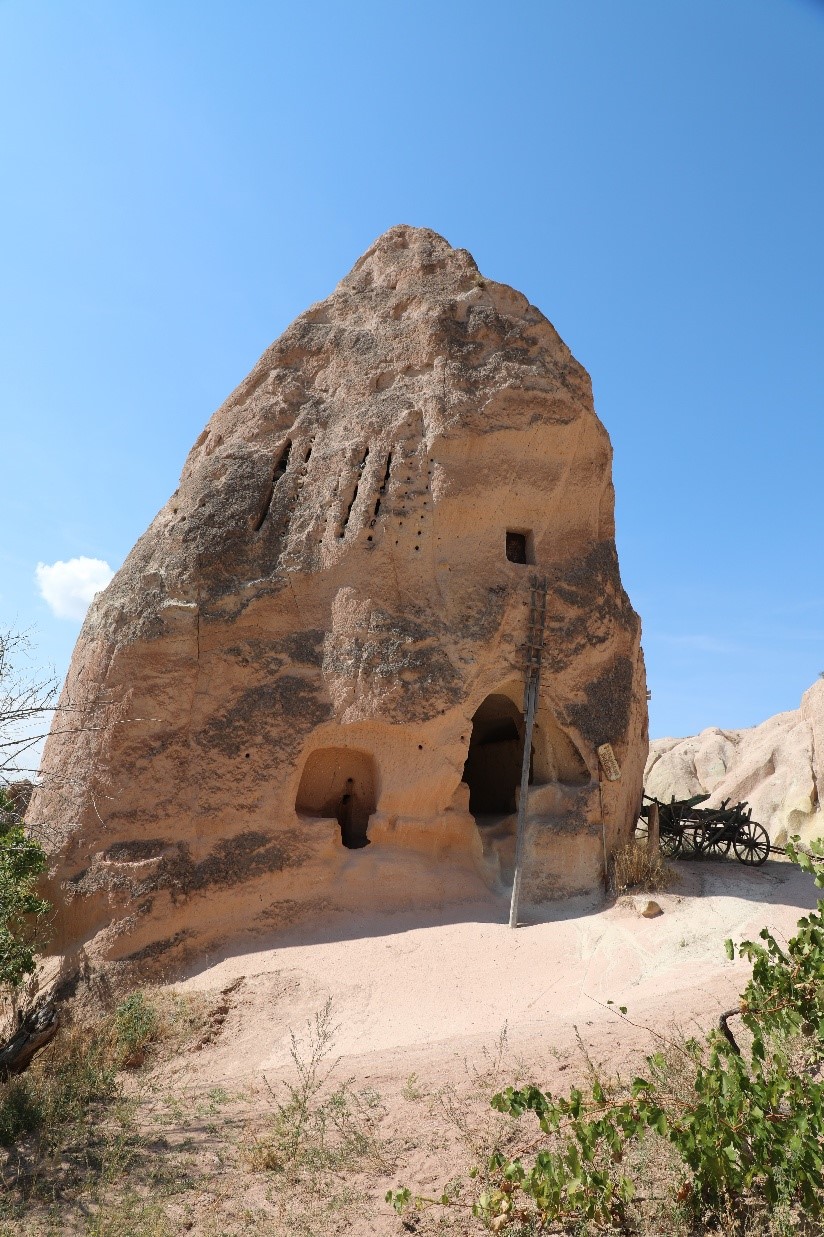General Information
Rock-Cut Apiaries in Cappadocia During the Byzantine Period
“The rock-cut apiaries identified during research in Cappadocia and dated to the Byzantine period are located in the valleys of Keşlik, Soğanlı, Uçhisar, Göreme, Kızılçukur, and Güllüdere II” (Güneri, 2023: 163).
“The apiaries, particularly those dated to the Middle Byzantine period, are significant not only for their role in agriculture but also for reflecting the economic and social structure of Byzantine society. These apiaries, along with dovecotes, stables, wine presses, and mills, illustrate the agricultural aspect of the Byzantine economy and provide insight into the standard of living of the local population. The Byzantines, who used wine and honey not only in agricultural production but also in religious rituals, often designed these structures together. Furthermore, the bee was incorporated into Byzantine iconography as a symbol of purity” (Güneri, 2023: 176).
"It is suggested that apiaries were built and used within monastic complexes, particularly near churches and in conjunction with winery. Honey was also used in rituals, including offerings of honeyed wine and honeyed bread, as well as in preparations for commemorating the deceased. In the Byzantine imperial palace, it was customary to serve dishes cooked with honey and honeyed wine, symbolizing imperial wealth. It is even recorded that during the Easter celebrations in Constantinople, the reservoir of a fountain along the route to Hagia Sophia was filled with wine and honey as a display of affluence” (Güneri, 2023: 160; Doğer & Borstlap, 2021: 32).
Historical Continuity and Dating Challenges
“Rock-cut apiaries, which are as old as the settlements in which they are found, should not only be evaluated as representations of the agricultural aspects of rural areas but also as significant elements of cultural heritage. Similar to the use of winery for wine production during the Byzantine period and their later adaptation for molasses production, apiaries were integrated into the broader architectural composition of the valleys and have continued to be used until recent times. However, as with other rock-cut structures, the absence of inscriptions or decorative elements poses a challenge for dating these apiaries. An approximate date has been determined by considering the historical context of the valleys, along with the spatial coherence and compatibility of the apiaries with other datable rock-cut buildings in the vicinity” (Güneri, 2023: 176).
Based on their integration with the historical landscape of the valleys and their association with other rock-cut structures, these apiaries are attributed to the Middle Byzantine period, specifically to the 10th or 11th century. Moreover, their continued use in rural areas until recent centuries has been documented (Güneri, 2023: 176).
Typology of Rock-Cut Apiaries in Cappadocia
Rock-cut apiaries in Cappadocia are dated to the Byzantine period, particularly the Middle Byzantine period, and hold significant importance in understanding the region’s agricultural landscape. These structures were designed to support honey production, protect bees, and enhance honey quality. Their commercial capacity is believed to have contributed to the local economy (Güneri, 2023: 175). The apiaries are classified into four main types:
- Type 1: Vertical shelving inside a niche with flight holes.
- Type 2: Horizontal shelving without a niche, featuring flight holes.
- Type 3: A niche with thin parallel vertical slits, without shelves.
- Type 4: A combination of flight holes and shelving within a niche, along with thin parallel vertical slits without shelves (Güneri, 2023: 163).
Apiaries Along the Güllüdere and Kızılçukur Valley Hiking Routes
Apiaries in Güllüdere Valley
- First Apiary: Located adjacent to a wine press, this structure belongs to Type 4. Designed with flight holes and vertical slits, it features a four-shelf arrangement. The presence of honeycomb remnants indicates that beekeeping activities continued until recent times (Güneri, 2023: 170).
- Second Apiary: Designed alongside a dovecote, this structure stands out with its advanced architectural features. It has a flat ceiling and a combination of horizontal and vertical shelving, classifying it as Type 4 (Güneri, 2023: 171).
Apiary in Kızılçukur Valley
Located near Üzümlü Church, this apiary is situated on the upper level of a two-story rock mass. The lower level functions as a winery, and access to the entrance is provided by a portable ladder. The interior is designed as a rectangular room oriented east-west, where beekeeping was conducted using both baskets and niches (Güneri, 2023: 169) (Photo 1).
Architectural Features of Byzantine Apiaries
Byzantine-period apiaries are characterized by flight holes that allow bees to enter, thin parallel vertical slits, and large niches. Inside, shelves were constructed to align with the flight holes, typically measuring 30-40 cm in width and 85-100 cm in depth (Güneri, 2023: 163). The ceilings are generally flat, while the floor plans are either square or rectangular. Some examples indicate that basket beekeeping was also practiced, suggesting a combination of different methods (Güneri, 2023: 169).
Historical and Cultural Significance
Beyond their role in Byzantine agriculture, apiaries also held religious and ritual significance as honey and wine were used in various ceremonies. The integration of these structures with winery and dovecotes highlights the Byzantines' agricultural expertise and economic strategies (Güneri, 2023: 176).
Even today, similar structures continue to be used in some rural areas, reinforcing their role as an enduring element of Cappadocia’s cultural heritage. However, the absence of inscriptions or decorative elements in these structures necessitates dating them based on their spatial relationship with other rock-cut buildings (Güneri, 2023: 176).
© 2025 Digital Cappadocia. All rights reserved. Unauthorized use of this content is prohibited.

